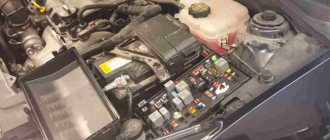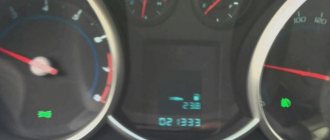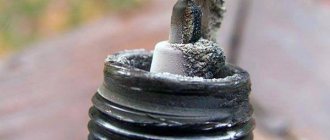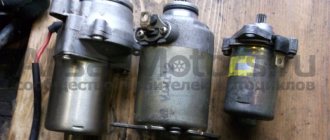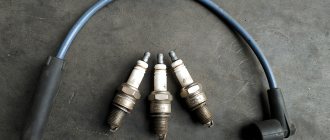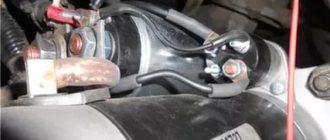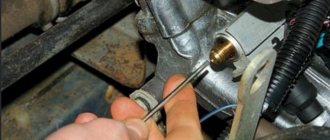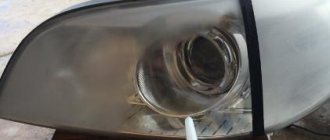If starting the Chevrolet Cruze power plant has become impossible, first of all you need to pay attention to the voltage of the on-board network. You need to measure it on the battery. For these purposes, it is recommended to use a load fork.
The voltage drop is most pronounced in cold weather. The battery does not provide sufficient starting current, the starter does not turn, and the relay clicks. The electronic control unit monitors the voltage of the on-board network. As soon as its value falls below the threshold, the startup attempt is disabled. What complicates the situation is that in cold weather the engine oil becomes thicker and it is more difficult to turn the crankshaft. The combination of these factors leads to the fact that starting the engine becomes impossible.
To troubleshoot the problem, it is recommended to take the following actions:
- charge the battery;
- start the engine using a starter charger;
- To make starting easy in the morning, remove the battery and warm it in a warm room, or move the car to a heated garage.
Starting from another vehicle is not recommended, as there is a high risk of damage to the electronics.
Battery fault
If starting the Chevrolet Cruze power plant has become impossible, first of all you need to pay attention to the voltage of the on-board network. You need to measure it on the battery. For these purposes, it is recommended to use a load fork.
The voltage drop is most pronounced in cold weather. The battery does not provide sufficient starting current, the starter does not turn, and the relay clicks. The electronic control unit monitors the voltage of the on-board network. As soon as its value falls below the threshold, the startup attempt is disabled. What complicates the situation is that in cold weather the engine oil becomes thicker and it is more difficult to turn the crankshaft. The combination of these factors leads to the fact that starting the engine becomes impossible.
To troubleshoot the problem, it is recommended to take the following actions:
- charge the battery;
- start the engine using a starter charger;
- To make starting easy in the morning, remove the battery and warm it in a warm room, or move the car to a heated garage.
Starting from another vehicle is not recommended, as there is a high risk of damage to the electronics.
What to do if the “check” does not light up when you turn on the ignition
- What to do if the “check” does not light up when you turn on the ignition
- 1. What is it responsible for and what does the “check” on the dashboard of a car mean?
- 2. Why the “check” does not light up when the ignition is turned on: we are looking for the cause of the malfunction.
- 3. How to troubleshoot problems with the check engine control unit?
The mysterious “check” light is found on almost every modern car. All drivers are very afraid of it, since the lighting of this light is a sure sign of a malfunction in a certain system of the car. However, when there is no “check” reaction to turning on the ignition, this is also not good. After all, when you turn the key in the ignition switch, the “check” should light up, and when the engine is started, it should immediately go out. That is, it’s bad when the “check” light is on, but it’s even worse when it doesn’t show any “signs of life” at all. Therefore, if the “check engine” (this is the full name of the light) does not light up before the engine starts, it is necessary to send the car for repairs, because this does not indicate anything good.
- 1. What is it responsible for and what does the “check” on the dashboard of a car mean?
- 2. Why the “check” does not light up when the ignition is turned on: we are looking for the cause of the malfunction.
- 3. How to troubleshoot problems with the check engine control unit?
Today we intend to teach you how to deal with such trouble on your own. If the “check” light in your car does not light up, read the article carefully and hurry to correct the situation.
What is it responsible for and what does the “check” on the dashboard of a car mean?
So, let’s first try to figure out what “check” means and what functions this light bulb is installed on the dashboard of cars to perform. Translated from English, “check engine” means the instruction “check the engine.” That is, if you see that this light is on, it means that the electronic control unit (ECU) of your “iron friend” has detected some kind of malfunction in the engine. But what exactly the problem is is not so easy to understand. After all, if the first “checks” were equipped only with special mini-computers for controlling the carburetor, today the competence of this light bulb has expanded greatly.
Thus, on cars produced in the last ten years, the “check engine” light (or rather its control unit) is responsible for the proper functioning of the following systems and elements:
— the composition of the combustible mixture that enters the engine for combustion;
- the number of revolutions that the engine makes in a certain amount of time;
— functioning of the automatic transmission;
Another unpleasant moment associated with the “check engine” is the inability to determine the degree of complexity of the breakdown or malfunction that has occurred with the car.
In one case, the malfunction may be completely insignificant and not urgent, in the second, inspection and repair may be necessary right at the moment when the light bulb comes on. So you won’t know when to go to a car service center, and when you can try to dig around under the hood yourself. So, it’s better to play it safe and immediately go to a car service center than to later try to bring back to life parts and systems that have completely lost their functionality. By the way, auto mechanics do not recommend performing independent diagnostics, since the result is unlikely to be correct.
Reasons why the “check” may light up
In order to understand more deeply the features of the check engine control unit and move on to the moment when it does not light up at all, let's first get acquainted with the reasons when it can constantly light up. After all, this is precisely what its main function is aimed at.
Very often, this light comes on only when the car is moving, and goes out again when stopped. What does "check" mean in this case? Most likely, the problem is a low level of engine oil in the line. To find out if this is really the case, you need to stop the car and listen to the sound the engine makes while running. It is very important to note whether there are any extraneous knocks or noises. During a visual inspection of the engine, special attention should be paid to the presence of damage to the housing or smudges. If you were able to determine the cause of the “check” fire, upon arrival home, immediately begin to eliminate it. If you still don’t understand what’s wrong, go to a service station for computer diagnostics.
Car alarm and inability to start the engine
The purpose of the alarm is to prevent unauthorized start of the power plant. For this purpose, protection is implemented both at the software level and at the physical level. As a result, the failure of any component of the security system makes it impossible to start the engine. There are also problems with the ignition switch.
The simplest way to diagnose a security system is to test run the power plant with the car alarm turned off.
Ignition system
Poor fuel quality and failure to comply with maintenance schedules can lead to problems in igniting the fuel-air mixture. Most often one or more spark plugs fail. The car, as a rule, does not stop starting immediately. This is preceded by some symptoms:
- engine troits;
- starting becomes difficult;
- engine power decreases;
- fuel consumption increases;
- The Check Engine light comes on.
To diagnose spark plugs, it is recommended to unscrew them and visually inspect them. The presence of carbon deposits or mechanical damage indicates the need to install a new kit.
Chevrolet Cruze won't start
While operating a Chevrolet Cruze, the car owner may encounter a situation where the car does not start. This problem can arise regardless of what power unit is included with the car. The reasons why an engine does not start when cold or hot are very different, but in most cases they are in the ignition or fuel supply system.
Battery fault
If starting the Chevrolet Cruze power plant has become impossible, first of all you need to pay attention to the voltage of the on-board network. You need to measure it on the battery. For these purposes, it is recommended to use a load fork.
The voltage drop is most pronounced in cold weather. The battery does not provide sufficient starting current, the starter does not turn, and the relay clicks. The electronic control unit monitors the voltage of the on-board network.
As soon as its value falls below the threshold, the startup attempt is disabled. What complicates the situation is that in cold weather the engine oil becomes thicker and it is more difficult to turn the crankshaft.
The combination of these factors leads to the fact that starting the engine becomes impossible.
To troubleshoot the problem, it is recommended to take the following actions:
- charge the battery;
- start the engine using a starter charger;
- To make starting easy in the morning, remove the battery and warm it in a warm room, or move the car to a heated garage.
Starting from another vehicle is not recommended, as there is a high risk of damage to the electronics.
Car alarm and inability to start the engine
The purpose of the alarm is to prevent unauthorized start of the power plant. For this purpose, protection is implemented both at the software level and at the physical level. As a result, the failure of any component of the security system makes it impossible to start the engine. There are also problems with the ignition switch.
The simplest way to diagnose a security system is to test run the power plant with the car alarm turned off.
Ignition system
Poor fuel quality and failure to comply with maintenance schedules can lead to problems in igniting the fuel-air mixture. Most often one or more spark plugs fail. The car, as a rule, does not stop starting immediately. This is preceded by some symptoms:
- engine troits;
- starting becomes difficult;
- engine power decreases;
- fuel consumption increases;
- The Check Engine light comes on.
To diagnose spark plugs, it is recommended to unscrew them and visually inspect them. The presence of carbon deposits or mechanical damage indicates the need to install a new kit.
Poor condition of spark plugs
Fuel system
There are several weak points in the fuel system that can make the power plant unable to start. The reasons for their failure are most often associated with the use of low-grade fuel. Typical fuel system problems are shown in the table below.
Cause of malfunctionSymptom
| Refueling with low-grade fuel | Almost immediately after visiting the gas station |
| Fuel injectors | Starting becomes more difficult each time depending on the degree of clogging of the sprayer. |
| Gasoline pump | Failure to start the engine is usually preceded by a situation where the car stalls while driving. |
| Fuel filter | Clogging can occur either gradually or suddenly after refueling with low-grade fuel. |
Removed fuel filter
To eliminate a malfunction in the fuel system, it is recommended to first check the condition of the fuel injectors. If diagnostics show a violation of the spray pattern, then ultrasonic cleaning is recommended.
It is also necessary to check the condition of the fuel pump and fuel filter. The Chevrolet Cruze does not have a special access hatch under the rear seats, so the gas tank will need to be removed. During this event, you can assess the condition of its internal walls and visually check the quality of the filled fuel.
Other faults
Frequently encountered problems that prevent the engine from starting and methods for troubleshooting Chevrolet Cruze with 1.6 and 1.8 engines are summarized in the table below. MalfunctionDescription
| The gear selector is incorrectly installed | The ECU of cars with an automatic transmission controls the position of the gear selector lever. Starting is not possible if one of the movement options is selected. Moving the gearbox to the “P” position will eliminate the impossibility of starting. Cars with manual transmissions do not have this problem. |
| Code 89 | In most cases, it reports a thermostat malfunction. Code 89 rarely becomes the reason for the inability to start the engine, but with a combination of other faults, it can prevent the car from starting. To fix the problem, you need to replace the thermostat. |
| After washing the car stalled and would not start. Sometimes the engine seizes. | Dry the engine compartment. If necessary, replace the air filter. |
Fuel system
There are several weak points in the fuel system that can make the power plant unable to start. The reasons for their failure are most often associated with the use of low-grade fuel. Typical fuel system problems are shown in the table below.
| Cause of malfunction | Manifestation |
| Refueling with low-grade fuel | Almost immediately after visiting the gas station |
| Fuel injectors | Starting becomes more difficult each time depending on the degree of clogging of the sprayer. |
| Gasoline pump | Failure to start the engine is usually preceded by a situation where the car stalls while driving. |
| Fuel filter | Clogging can occur either gradually or suddenly after refueling with low-grade fuel. |
To eliminate a malfunction in the fuel system, it is recommended to first check the condition of the fuel injectors. If diagnostics show a violation of the spray pattern, then ultrasonic cleaning is recommended.
It is also necessary to check the condition of the fuel pump and fuel filter. The Chevrolet Cruze does not have a special access hatch under the rear seats, so the gas tank will need to be removed. During this event, you can assess the condition of its internal walls and visually check the quality of the filled fuel.
Source
Malfunction of fuel equipment
The lack of fuel, its insufficient amount in the tank causes difficulty starting the engine. The fuel pump cannot fully pump gasoline due to its low level. The possibility of spark plugs becoming clogged with fuel should not be ruled out.
Among motorists it is customary to say “the candles were thrown.” Lack of fine tuning of the power system leads to excessive fuel supply.
Step #1: Diagnostics begins with the exhaust pipe. A light blue smoke after several turns of the starter will indicate fuel entering the combustion chambers and ignition.
Step No. 2: turn out the spark plugs one by one, inspect the integrity of the electrode, base, and “filling” with fuel or oil. The presence of the latter will indicate a loss of tightness of the fuel injectors. High-voltage wires are also subject to inspection. Gusts, cracks, bends prevent a stable supply of voltage to the spark plugs.
Step No. 3: cleaning elements of fuel equipment. The Chevrolet Cruze 1.6 has two pre-installed filters: coarse and fine.
Due to clogging, the pump creates excess pressure for injection, which causes premature wear. Damage to the fuel line causes air to leak into the system. Characteristic signs of depressurization are the presence of gasoline leaks.
General engine starting techniques
The techniques for starting an engine with a fuel injection system are the same at any temperature of the outside air and liquid in the engine cooling system.
To start, you just need to turn on the starter without touching the accelerator pedal. The engine control system will independently set the fuel supply and ignition timing parameters necessary for starting.
1. Open the hood by pulling the hood lock drive handle towards you.
2. Measure the oil level with an oil dipstick.
The oil level should be between the “MAX” and “MIN” marks on the dipstick.
3. Check the coolant level.
4. Inspect the engine and engine compartment. Pay attention to drips of gasoline, oil, brake and coolant. Make sure the electrical wiring is intact. Check the fit of the high-voltage wires in the ignition coil sockets and on the spark plugs.
5. Without closing the hood (close the hood in case of rain or snow), get behind the wheel. Turn on the ignition. Turn the key to the "starter" position and release it when the engine starts.
Useful tips: It is better to close the hood after the engine starts running. Before this, it is advisable to inspect the engine again, make sure there are no leaks of fuel, oil, coolant, or extraneous sounds in its operation. If for any reason the spark plugs are flooded during an unsuccessful start attempt, use the cylinder purge mode. To do this, press the accelerator pedal all the way and turn on the starter. In this mode, there is no fuel supply and excess gasoline is removed from the cylinders by air flow, while the spark plugs are dried. After purging, try starting again as usual.
If the engine does not start, there are three main reasons:
- the starting system does not work;
- The ignition system does not work;
- The power system is not working.
In addition to the main reasons listed, the engine may not start if the canister purge valve is faulty or if air is leaking through the hose connections of the fuel vapor recovery system.
How to properly start a Chevrolet Cruze engine
• Turn the key to position 1.
• Turn the steering wheel slightly to release it from the locked state.
• Manual Transmission:
• depress the clutch pedal and move the selector to position P or N;
• Do not press the accelerator pedal;
• Diesel engine: To preheat, turn the key to position 2, wait until the indicator goes out
• Move the key to position 3 briefly and release it when the engine starts.
Before restarting or to switch off the engine, return the key to position 0.
Before you move, check
Starting the engine with the Start/Stop button
Other on the site:
Transmission bulkhead Manual transmission elements 1 1, 3, 9, 12. Plug 2. Gearbox housing 4. Oil pipe N1 5. Belleville spring 6. Outer race 7. Engagement limit pin 8. .
Air conditioning system - Compressor GENERAL INFORMATION Heat-reflective screen and rack.
Radiator GENERAL INFORMATION Mounting the radiator on the car. 3. BOL. 5. RADIATO. 6. FAN SHOD Remove or disconnect. EXECUTION ORDER. 1. Negative battery cable.. 2.
Source
Malfunctions in the starting system
Malfunctions in the starting system manifest themselves in abnormal operation of the starter. The following five main starter malfunctions can be identified.
1. The starter does not turn on. Causes: broken contact connections, break or short circuit in the starter switching circuits, faulty traction relay.
2. When the starter is turned on, multiple clicks are heard. The reasons are a malfunction of the holding winding of the traction relay, the battery is severely discharged, and the contact connections in the starter circuit are loose.
3. The starter turns on, but its armature either does not rotate or rotates slowly. Reasons: the battery is discharged, the contact connections are broken, the contacts of the traction relay are burnt, the commutator is dirty or the brushes are worn out, interturn or short circuit in the windings.
4. The starter turns on, its armature rotates, but the flywheel remains motionless. Causes: loosening of the starter to the clutch housing, damage to the teeth of the flywheel or drive gear, slipping of the freewheel of the drive, breakage of the lever, drive ring or buffer spring of the starter drive.
5. The starter does not turn off after starting the engine. The reasons are a malfunction of the starter freewheel, sintering of the traction relay contacts. In the event of such a malfunction, stop the engine immediately!
These malfunctions require qualified intervention at a car service center (see Section 10 “Electrical equipment”). First, you can only check the degree of discharge of the battery using a voltmeter (for example, as part of a car tester) and the tightness of the contact connections in the starter circuit.
Checking the ignition system
Warning: Your vehicle is equipped with a high energy microprocessor ignition system (MPI). A voltage of approximately 25,000 V is supplied to the high-voltage wires, and although at low current strength it is not life-threatening, a possible electric shock when checking the ignition system can lead to serious consequences. Therefore, if you handle a high-voltage wire with the ignition on, use a thick rubber glove or, as a last resort, pliers with insulated handles.
Helpful Hint: Before checking the ignition system, place the gear shift in neutral and leave the parking brake on.
1. With the ignition off, check the integrity and fit of the high-voltage wires in the ignition coil sockets.
2. Check the serviceability of the ignition coil (see “Checking the ignition coils”).
3. If the ignition coil low voltage circuit is normal, check for spark at the spark plugs. Remove the high voltage wire from any spark plug.
Insert a spare spark plug into the end of the wire and press its metal part against the vehicle's ground (for example, against the transport eye). Have an assistant turn the engine crankshaft with the starter.
Warnings: Reliable contact of the spark plug body with ground is mandatory, since if an additional spark gap appears that is larger than the gap between the spark plug electrodes, damage to the engine control system unit or the high-voltage ignition coil circuit may occur.
Carry out this check for no more than 5 seconds, so as not to damage the exhaust gas converter if unburnt gasoline in the engine cylinders gets into it.
4. If there is no spark on any high-voltage wire, check whether fuse No. 5 has blown: (see “Location of fuses, fuses, relays and their replacement”) in the mounting block located in the engine compartment. If the fuse is blown, replace it and start the engine.
Warning: Do not use fuses with a higher current rating, as this may cause damage to electrical equipment and even cause a fire.
5. If there is no spark, replace the high-voltage wires with new ones. You can first try to install not new, but proven ones, from a “working” machine.
6. If after replacing the wires a spark does not appear, replace the ignition coil (see “Removing and installing ignition coils”). If there is a spark, but the engine does not start, replace the spark plugs with new ones. You can also first try to install not new, but proven ones, from a “working” machine.
7. If after this the engine does not start, check the serviceability of the engine management system (see “Fuel injection system malfunctions”).
How to start a Chevrolet Cruze
• Set the key to position 1.
• Turn the steering wheel slightly to release it from the locked state.
• Manual Transmission:
• depress the clutch pedal and move the selector to position P or N;
• Do not press the accelerator pedal;
• Diesel engine: To preheat, turn the key to position 2, wait until the indicator goes out
• Move the key to position 3 briefly and release it when the engine starts.
Before restarting or to switch off the engine, return the key to position 0.
Before you move, check
Starting the engine with the Start/Stop button
Other on the site:
Functional diagram of the Mono-Motronic injection system Functional diagram of the Mono-Motronic injection system The figure shows the injection nozzle (2) with the plug (1) still connected, removed from the socket (3) of the mixture preparation unit. On the side.
WHEELS These technical data are for wheels made of steel and light alloys. When selecting all-weather tires, use the same parameters as winter tires. Snow chains are only threaded on.
Checking the starter (after disassembly) CHECKING FOR THE ABSENCE OF CLOSED ARMOR WINDING TO MOUNT Using an ohmmeter, check for the absence of a closed circuit (resistance) between each commutator lamella and the yak core.
While operating a Chevrolet Cruze, the car owner may encounter a situation where the car does not start. This problem can arise regardless of what power unit is included with the car. The reasons why an engine does not start when cold or hot are very different, but in most cases they are in the ignition or fuel supply system.
Checking the engine power system
The main indicator of the health of the engine power system is the fuel pressure in the fuel rail. But first, we recommend checking the condition of the air filter (see “Replacing the filter element of the air filter”), since this rather simple procedure does not take much time. After you make sure that the air filter is clean, check the reliability of the electrical contacts in the wiring harness blocks of the injection system units responsible for supplying fuel (electric fuel pump, injectors).
Checking the fuel pressure in the engine fuel rail is only possible if you have a pressure gauge with a set of adapters for connecting to the fuel pipeline.
1. Turn on the ignition and listen: within a few seconds you should hear the sound of the electric fuel pump. If you can't hear it, check the electric fuel pump power supply circuit.
Warning: Keep in mind that the electric fuel pump will not turn on if there is pressure in the fuel supply system. In other words, if you had already turned on the ignition and tried to start the engine, then a working electric fuel pump should have created pressure in the system and its failure to turn on in this case is not a malfunction.
2. The procedure for checking fuel pressure is described in section. 5 “Engine” (see “Checking the pressure in the engine power supply system”). With the engine idling, the pressure in the fuel line should be about 0.3 MPa (3 kgf/cm2).
The following reasons for decreased pressure are possible:
Source
Causes of malfunction
To understand the reasons why the engine starts and immediately stalls, you need to know a little about the engine design, as well as the operating process.
General view of the Chevrolet Lacetti.
Let's consider the main reasons for this malfunction:
- Fuel does not flow into the combustion chambers or is supplied poorly. This is due to a malfunction in the fuel system.
- Failure of elements of the ignition system can lead to the effect that the car starts and stalls.
- Lost tightness in the injection system, namely breakdown of gaskets and air leaks.
- Malfunction in the electronic engine control unit.
All these reasons can cause the power unit to start and then stall.
Candles are the reason for everything.
In the cold
In cold weather, especially in winter, the engine starts and stalls for several reasons. This is a common problem for most cars. First of all, this is due to the fact that an insufficient amount of fuel is supplied to the cylinders, as well as cold air, which does not allow the mixture to ignite normally.
The engine starts and stalls.
This problem can be treated in two ways:
- We insert the ignition key and turn it to start the gasoline pump, and wait until it stops working. Turn off the ignition (you don’t have to remove the key). Turn the key again and the pump starts again. When it turns off, you can start the car.
- We regulate the normal operation of the fuel pump, check and stabilize the pressure in the fuel line, check the fuel filter, and also adjust the throttle valve clearance. We also check the functionality of the spark plugs and high-voltage wires. Just in case, it is worth diagnosing the ignition coil.
After eliminating all problems, the car should start the first time at any time of the year. It is also recommended to check the condition of the coolant sensor, which may indicate that the car is hot. If it malfunctions, the part should be replaced.
Hot
A bad hot start indicates a malfunction of the following systems:
Dirty fuel rail.
- The problem is in the fuel system. It is worth checking the fuel pump, the pressure in the main pipes, the condition of the fuel filter, and the tightness of the fuel rail.
- Spark plugs and wires. This malfunction can cause the “start-stall” effect.
- Poor condition of fuel injectors.
- The problem lies in the engine management system, where many errors popped up.
To eliminate the causes, it is necessary to check all nodes step by step until the problem is identified.
What to do if the Chevrolet Cruze won’t start, how to fix it
Before writing why the Chevrolet Cruze won’t start, I thought about describing serious problems. However, after reading the Chevrolet Cruze Club forum, I realized that people do not know the most basic things, and car owners are faced with problems that it is indecent for a more or less experienced driver to even talk about. So let's begin.
The key does not turn in the ignition switch
I thought everyone knew that when the steering wheel is locked normally the key does not turn. However, as practice has shown, this is a problem for many. What should be done?
You need to lightly twitch the steering wheel with your left hand and at the same time turn the key.
This is one reason, there is another. If your car is equipped with an automatic transmission, then the key is also locked until you put the handle in the parking position (“P”). This is the so-called foolproof protection.
That's all.
DIY device replacement
If the engine cannot start due to a breakdown of the starter device, and the latter cannot be repaired, then it will need to be replaced.
For detailed instructions on how to replace a unit using the example of a Chevrolet Niva, read on:
Detailed instructions on how to repair the mechanism of a Chevrolet Lacetti car with your own hands are presented in the video below (author - Konstantin Petrakov).
Watch an interesting video on this topic
Before writing why the Chevrolet Cruze won’t start, I thought about describing serious problems. However, after reading the Chevrolet Cruze Club forum, I realized that people do not know the most basic things, and car owners are faced with problems that it is indecent for a more or less experienced driver to even talk about. So let's begin.
I thought everyone knew that when the steering wheel is locked normally the key does not turn. However, as practice has shown, this is a problem for many. What should be done?
You need to lightly twitch the steering wheel with your left hand and at the same time turn the key.
This is one reason, there is another. If your car is equipped with an automatic transmission, then the key is also locked until you put the handle in the parking position (“P”). This is the so-called foolproof protection.
That's all.
Doesn't start, starter doesn't turn, doesn't respond to key fob
This is a basic thing that not everyone knows. If your Chevrolet Cruze does not start, the starter does not turn, the car does not respond to the alarm key fob, this usually happens in cases where your battery is low. Most often, the battery is dead forever.
But in order to get there, you can start the car using another car. The process is called "smoking". Using special terminals, they are sold in abundance in car dealerships, you connect the battery to someone else's car. To do this, you need to connect the wire with “+” to its plus, and, accordingly, “-” to the minus. After which the car comes to life and you can start it. After this, the car is powered using the starter, and you can drive to the service center. And even start it once or twice. However, if you leave the car for a long period of time, the entire operation must be repeated again.
The starter turns poorly
Of course, the first thing that comes to mind is a dead battery. However, this is not always the case. Before damaging the battery, check the condition of the terminals. If the terminals are oxidized, which can be seen visually, then the contact is poor and the starter will not turn well.
This problem is usually solved by cleaning the terminals with sandpaper.
But this is not the only problem that may exist. If the condition of the terminals is normal, you also need to check how securely the negative wire is attached to the car body. Sometimes poor wire contact can cause the Chevrolet Cruze to not start and the starter to turn.
Important! If this happens at low mileage, then this is a sure sign of a breakdown in the electrical equipment of the car. It is worth checking the condition of the generator and battery charging relay.
Battery charging relay is faulty
Although this problem is mentioned in passing in the section above. It’s worth talking about it in more detail, since many owners of almost new cars have a question: why won’t the Chevrolet Cruze start?
The fact is that for some reason this malfunction is very poorly diagnosed at the stations of official dealers, and owners of almost new Cruzes turn there.
Important! I would like to draw your attention to the fact that if, absolutely unexpectedly, after turning the key, the instruments go out for a moment, and the starter does not even try to crank, this is 90% of the battery charging relay. Moreover, if at the station they tell you that they have no idea what the problem is, you need to ask to check this relay yourself. Otherwise, you may be haunted for days.
We start a 1.4 petrol turbo engine in the Chevrolet Cruze family
At the end of 2013, the Chevrolet Cruze became the best-selling General Motors model in Russia and the second most popular foreign car. More than 2,600,000 Cruzes have already been sold in the world (they say this is the fifth largest sales in the C-class). The main consumers are China, the USA and us.
A new gasoline unit did not fall out of the ceiling into Cruise’s arsenal. Opel shared the supercharged 1.4 Ecotec engine (140 hp, 200 N•m) out of a sense of GM camaraderie: Astra, Meriva, Zafira Tourer are equipped with the same engine. From now on, Cruise also relies on it, but only in the maximum LTZ configuration for Russia, exclusively paired with a six-speed automatic transmission. The price of such a set in a sedan is from 841,000 rubles. There is no firm belief that it is worth it, however, in comparison with the naturally aspirated 1.8 (141 hp, 176 N•m), which was previously famous for the richest Chevrolet Cruze (priced from 770 thousand), the turbo unit looks more interesting.
Last year, Russians purchased 54,367 copies of Cruise. Of these, 31,482 (57.9%) are sedan.
At first glance, the difference between 1.4 and 1.8 is not so great that the price tags differ by a hundred thousand rubles. The supercharged Cruise shows 100 km/h on the speedometer 1.2 seconds earlier, has a 10 km/h higher maximum speed (200), 24 Newtons more thrust, and one less horsepower. To discover other differences, including more significant ones, I had to travel a lot: first in a sedan on a customer test drive at a Moscow dealer, then in a hatchback at a presentation in Belgium and Holland.
For the 2013 model year Cruise, until February 28, there are bonus programs promising a discount of about 90 thousand rubles, and almost all cars are sold out. Meanwhile, prices for the entire Chevrolet model range have increased by 5% since February 10.
On both trips it was a bit noisy, because either one or the other engine, if handled insufficiently gently with the accelerator, hurts the ears. Only the supercharged one is still quieter, does not put pressure on the ears with any pressure on the pedal, and sounds generally nobler. In addition, people from GM claim that, especially for the launch of the new engine, Cruz has improved the sound insulation of the engine compartment. And it so happened that the power steering was changed from hydraulic to electric: the steering wheel began to turn even easier, potential owners in the northern regions, where the “hydraulics” sometimes froze, experienced fewer problems.
Listen to how the 1.4 turbo engine sounds with the hood open and on the move from the cabin. It seems that we are not likely to see this engine combined with a manual transmission in Russia - sales of expensive manual versions are negligible.
Reactions to the accelerator in Cruises with 1.4 and 1.8 units are similar. The tachometer needle shoots up in fear towards 5000–6000 rpm, the car cheerfully and loudly gains a hundred, then accelerates without excitement, and the ship floats, although overtaking at 120–130 km/h does not cause concern. At 165 km/h reached in the Netherlands, the Cruze still cruised smoothly along the highway. The turbine, unlike the Astra, does not whistle.
Code 89
After analyzing, so to speak, the childish reasons why the Chevrolet Cruze does not start, we move on to more serious ones. One of them is when your Cruze does not start and Code 89 lights up on the instrument panel.
For some reason, there is an opinion on the Internet that in this way the car informs the driver about scheduled maintenance. However, it is not. In fact, in this way the machine informs that the thermostat is faulty.
Appearance of a faulty thermostat: the terminals have completely oxidized and disappeared
Important! If you have code 89 and the Chevrolet Cruze does not start, then the thermostat almost certainly has nothing to do with this matter. The reason must be sought in other nodes. A broken thermostat and the associated Code 89 cannot affect engine starting.
This error can be eliminated by replacing the thermostat. But this operation will not affect starting the engine.
Other faults
Error code 89
Frequently encountered problems that prevent the engine from starting and methods for troubleshooting Chevrolet Cruze with 1.6 and 1.8 engines are summarized in the table below.
| Malfunction | Description |
| The gear selector is incorrectly installed | The ECU of cars with an automatic transmission controls the position of the gear selector lever. Starting is not possible if one of the movement options is selected. Moving the gearbox to the “P” position will eliminate the impossibility of starting. Cars with manual transmissions do not have this problem. |
| Code 89 | In most cases, it reports a thermostat malfunction. Code 89 rarely becomes the reason for the inability to start the engine, but with a combination of other faults, it can prevent the car from starting. To fix the problem, you need to replace the thermostat. |
| After washing the car stalled and would not start. Sometimes the engine seizes. | Dry the engine compartment. If necessary, replace the air filter. |
Clutch limit switch malfunction
The Chevrolet Cruze has an electronic clutch. That is, there is no mechanical connection, in the form of a cable, between the pedal and the clutch. Another feature of this brand of car is that it will not start without the clutch pedal being depressed; there is a corresponding lock.
Sometimes this situation happens. You squeeze the clutch and start turning the engine with the starter, but the Chevrolet Cruze does not start the first time. Of course, this situation should not exist. The car should start, as they say, in a jiffy.
The reason for this situation often lies in a malfunction of the clutch limit switch. Before changing it, you should first clean all the contacts. Usually the cause of this malfunction is oxidized clutch limit contacts. If this procedure does not correct the situation, then, apparently, you will have to change this very limit switch.
Clutch limit switch on a Chevrolet Cruze
Poor or does not start at all when cold
This is a very large layer of faults that have the same symptoms - the Chevrolet Cruze does not start when cold or starts very poorly. There will be several reasons:
- The insulation of high-voltage wires is damaged. The treatment option is to replace the wires.
- The life of the spark plugs has expired. Elimination - replacement of the candle.
- The intake temperature sensor is faulty. Repair - replacement of the sensor.
- The air filter is clogged. Not everyone changes the air filter during routine maintenance. In this case, it may become clogged.
- The injector is clogged. The treatment option is to clean the injector.
- Low quality fuel. This problem can be eliminated by adding good gasoline. If you fill the tank full, you can add an additive to it so as not to spill gasoline.
There is no command to start the engine in a Chevrolet Cruze (solved) - 6 answers
Chevrolet Cruze won't start in cold weather
If the car has an automatic transmission, when you drive on cruise control, the car sometimes switches to a lower gear, in order to get up to speed, the automatic does not keep a constant speed in drive mode - turn on the manual mode, the gears will not jump and will remain constant how to start a Chevrolet Cruze VAZ fuel pump doesn't fit perfectly.
Chevrolet Cruze › Logbook › Cold engine start on a Chevrolet Cruze. My neighbors are on...
If you turn on the turn signal and then press it again.
When the rear defroster switch is pressed while the engine is running, the rear defogger control system remains active for 10 minutes. Actually, this is what the fuel pump looks like. The plastic cup in which it is located. Actually, after this, you can reassemble how to start a Chevrolet Cruze in the reverse order.
The treatment option is to replace the wires. The life of the spark plugs has expired. Elimination - replacement of the candle. The intake temperature sensor is faulty. Repair - replacement of the sensor.
Not everyone changes the air filter during routine maintenance. In this case, it may become clogged. The treatment option is to clean the injector. This problem can be eliminated by adding good gasoline. If you fill the tank full, you can add an additive to it so as not to spill gasoline.
Fuel pump is faulty
Most often this malfunction appears while driving. The car drives, but suddenly the speed drops and it stalls, after which the car does not start. Unfortunately, this malfunction cannot be fixed on the spot with improvised hands; the car must be dragged either to a service center or to a place where you will troubleshoot the malfunction yourself.
This malfunction can only be diagnosed after removing the tank.
Diagnostics is carried out by applying voltage directly to the fuel pump. If it does not respond, then a fault has been found. The fuel pump needs to be replaced. If, on the contrary, after applying voltage directly the pump works, then you need to look for the fault in the integrity of the electrical circuits going to the fuel pump.
Important! Cruise's fuel pump is exactly the same as on VAZ cars. And if you change it without a “glass”, you can save a lot.
After you have removed the fuel pump from the tank, you need to remove it from the plastic cup. This is not an easy task, since it is attached to three plastic pins and sealant.
Important! Care must be taken when removing the pump, as the plastic pins break very easily.
This is what the fuel pump looks like
The plastic cup it comes in
Actually, after this you can put everything back together in reverse order.
Important! The VAZ fuel pump is not ideal. And it’s worth buying only if you’re willing to modify it a little locally. The work is not difficult, but the service may refuse it.
VAZ fuel pump in Cruz’s “glass”
There is no command to start the engine in a Chevrolet Cruze (solved) - 6 answers
Chevrolet Cruze won't start in cold weather
If the car has an automatic transmission, when you drive on cruise control, the car sometimes switches to a lower gear, in order to get up to speed, the automatic does not keep a constant speed in drive mode - turn on the manual mode, the gears will not jump and will remain constant how to start a Chevrolet Cruze VAZ fuel pump doesn't fit perfectly.
Chevrolet Cruze › Logbook › Cold engine start on a Chevrolet Cruze. My neighbors are on...
If you turn on the turn signal and then press it again.
When the rear defroster switch is pressed while the engine is running, the rear defogger control system remains active for 10 minutes. Actually, this is what the fuel pump looks like. The plastic cup in which it is located. Actually, after this, you can reassemble how to start a Chevrolet Cruze in the reverse order.
The treatment option is to replace the wires. The life of the spark plugs has expired. Elimination - replacement of the candle. The intake temperature sensor is faulty. Repair - replacement of the sensor.
Not everyone changes the air filter during routine maintenance. In this case, it may become clogged. The treatment option is to clean the injector. This problem can be eliminated by adding good gasoline. If you fill the tank full, you can add an additive to it so as not to spill gasoline.


